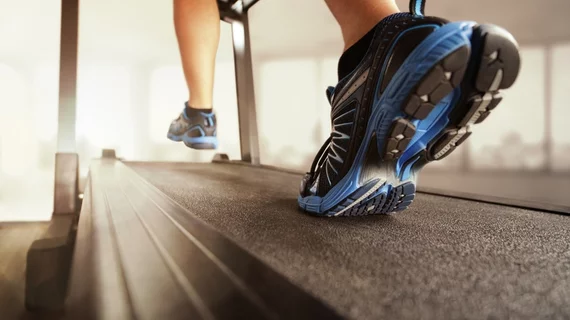Walk this way: How treadmill workstations affect radiologist efficiency
Treadmill desks have gained popularity in recent years, but how would utilizing one impact a radiologist’s ability to interpret medical imaging results?
According to research published in the Journal of the American College of Radiology, using a treadmill workstation while interpreting CT examinations does not change a radiologist’s ability to detect lung nodules. It also leads to a quicker interpretation time.
“To our knowledge, no other studies regarding specific effects of dynamic workstation use on radiologist accuracy or examination interpretation time have been published,” wrote Cody R. Johnson, LT, MC, USN, department of radiology at the Naval Medical Center Portsmouth in Portsmouth, Virginia, and colleagues. “In our study, we chose to evaluate the seated and walking positions because of the available literature regarding the effects of walking on dynamic treadmill workstations and its effects on cognitive function as well as office tasks.”
The authors asked a team of four radiologists to provide a retrospective review of 55 CT scans of the chest. Three of those readers interpreted the examinations under two different conditions—either seated at a conventional workstation or while using a dynamic treadmill workstation—and the fourth reader remained seated at a conventional workstation the entire time. The seated radiologist served as the study’s gold standard.
The three radiologists each interpreted 28 CT scans selected by random while seated. Then, at least two weeks later, they interpreted those same 28 CT scans in a different order while using the dynamic workstation. The same process was repeated for the remaining 27 CT scans, though they interpreted them while using the dynamic workstation first and then followed that up at least two weeks later by reading them while seated.
Overall, the researchers noted “no statistically significant difference” in the number of nodules the radiologists detected whether they were seated or using the treadmill desk. The gold standard radiologist detected an average of 10.1 nodules per examination, and each reviewer’s average number of nodules per examination ranged from 9 to 14. The three radiologists who alternated between sitting and using the treadmill desk detected a mean of 13.7, 14.4 and 9.2 total nodules per examination while seated. While using the treadmill, they detected a mean of 13, 12.6 and 8.3 total nodules per examination.
“Our study demonstrated no significant difference in the detection of total number of pulmonary nodules between walking at a dynamic workstation and sitting,” the authors wrote.
In addition, the radiologists’ follow-up recommendations were in agreement when they were seated vs. when they were using the treadmill 89 percent of the time.
The radiologists also interpreted the CT scans faster while using the treadmill desk. One radiologist took a mean of 179 seconds to complete each examination seated, but 121 seconds while using the treadmill. Another radiologist took a mean of 186 seconds to complete each examination seated, but 150 seconds while using the treadmill. The third radiologist took a mean of 209 seconds to complete each examination seated, but 164 seconds while using the treadmill. Overall, the mean time for the three readers was 186 seconds seated and 145 seconds while using the treadmill.
“It is unclear whether this statistically significant difference in interpretation time is clinically relevant,” the authors wrote. “Regardless, increasing radiologist productivity while also positively contributing to their health would be of benefit in the setting of an increasing demand for imaging studies.”

